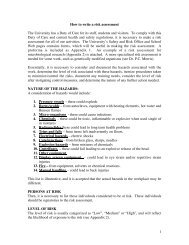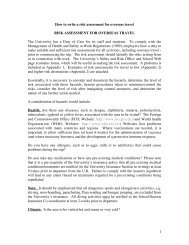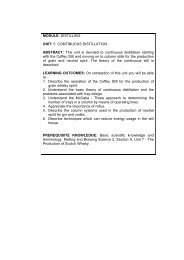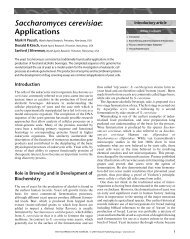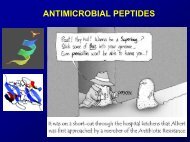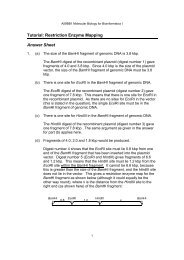Chapter 11 Production of Scotch and Irish whiskies: their history and ...
Chapter 11 Production of Scotch and Irish whiskies: their history and ...
Chapter 11 Production of Scotch and Irish whiskies: their history and ...
You also want an ePaper? Increase the reach of your titles
YUMPU automatically turns print PDFs into web optimized ePapers that Google loves.
<strong>Production</strong> <strong>of</strong> <strong>Scotch</strong> <strong>and</strong> <strong>Irish</strong> <strong>whiskies</strong>: <strong>their</strong> <strong>history</strong> <strong>and</strong> evolution 157aided by the disappearance <strong>of</strong> a bluish tinge whenwater is added to the distillate. The monitoringprocess takes place in a spirit safe secured witha Government Excise lock. Collection <strong>of</strong> thedistillate is terminated when the alcohol contenthas fallen to a specified value, although distillation<strong>of</strong> the feints or tails is continued until all <strong>of</strong> thealcohol has been removed from the low wines.The residue remaining in the spirit still is knownas ‘spent lees’, <strong>and</strong> like pot ale is either run towaste or evaporated to manufacture animal feed.The whisky distilled over in the middle fractionhas an alcohol content <strong>of</strong> 63-70 o GL.The manufacture <strong>of</strong> <strong>Irish</strong> whiskey involvesthree rather than two distillations (Figure <strong>11</strong>). Thefermented beer is heated in the wash still, <strong>and</strong>the first distillation (‘strong low wines’) is collecteduntil the distillate reaches a predeterminedspecific gravity. The distillate, then known as‘weak low wines’, is switched into a separatevessel. The weak low wines are pumped intothe low wines still <strong>and</strong> are re-distilled to producetwo fractions termed ‘strong feints’ <strong>and</strong> ‘weakfeints’. Strong feints are mixed with the stronglow wines in a spirit still. Distillates from this arecollected in the same fashion as in production<strong>of</strong> <strong>Scotch</strong>. The whiskey collected usually is about89-92 o GL.Continuous distillationNo fundamental changes have been introducedinto the design <strong>of</strong> the patent or C<strong>of</strong>fey still overthe past century. Automation, particularly <strong>of</strong> thebeer feed, is now commonplace, as is continuousmonitoring <strong>of</strong> other stages in the distillationprocess. Nevertheless, many <strong>Scotch</strong> <strong>and</strong> <strong>Irish</strong>producers <strong>of</strong> grain <strong>whiskies</strong> continue to use astill which, like the original C<strong>of</strong>fey still, has justtwo columns: a beer stripper (or analyzer) <strong>and</strong> arectifier.A description <strong>of</strong> the operation <strong>of</strong> two columncontinuous stills in the manufacture <strong>of</strong> <strong>Scotch</strong>grain whisky has come from Pyke (1965). Inorder to obtain whisky <strong>of</strong> high quality from thesestills, they must be operated such that the alcoholconcentration <strong>of</strong> the spirit at the spirit draw trayin the rectifier is not less than 94.17 o GL. Themanner in which the precise control <strong>of</strong> stilloperation can affect the composition <strong>of</strong> thewhisky is shown in Figure 12. As illustrated, ifconditions are changed in either direction on theabscissa, the concentration <strong>of</strong> congeners willalter with a possible adverse effect on finalproduct quality.Maturation <strong>and</strong> agingFreshly distilled whisky <strong>of</strong> any type is verydifferent from the spirit that is later bottled, eithersingly or blended. The transformation is broughtabout by storing the whisky in oak barrels forperiods <strong>of</strong> time that depend on traditionalpractice <strong>and</strong> legal requirements. In general,<strong>whiskies</strong> are matured for far longer than thelegally-required period <strong>of</strong> time. The raw spirit istaken by pipeline from the distillation plant to thetank house where it is diluted with water to therequired strength <strong>and</strong> then transferred intobarrels.Maturation in barrels is accompanied by a loss<strong>of</strong> liquid by evaporation, <strong>and</strong> the relative rates <strong>of</strong>loss <strong>of</strong> water <strong>and</strong> <strong>of</strong> alcohol determine whetherthe aged whisky has a higher or lower alcoholicstrength than that at filling. In Scotl<strong>and</strong>, wherethe barrels <strong>of</strong> whisky are stored in cool,unheated, but humid warehouses, the alcoholicstrength decreases (Valaer, 1940). In contrastValaer <strong>and</strong> Frazier (1936) reported that in theUS storage conditions cause an increase inalcoholic strength. Maturation in barrels is alsoaccompanied by changes in the chemicalcomposition <strong>of</strong> the whisky. These changes areattributable to extraction <strong>of</strong> wood constituentsfrom the barrel, oxidation <strong>of</strong> components presentin the original whisky as well as those extractedfrom the wood, reactions between componentsin the whisky <strong>and</strong> removal <strong>and</strong> oxidation <strong>of</strong> highlyvolatile sulfur components by the carbon charon the inner surface <strong>of</strong> the barrel.Some <strong>of</strong> the earlier investigators reported onchanges in the composition <strong>of</strong> the major classes







